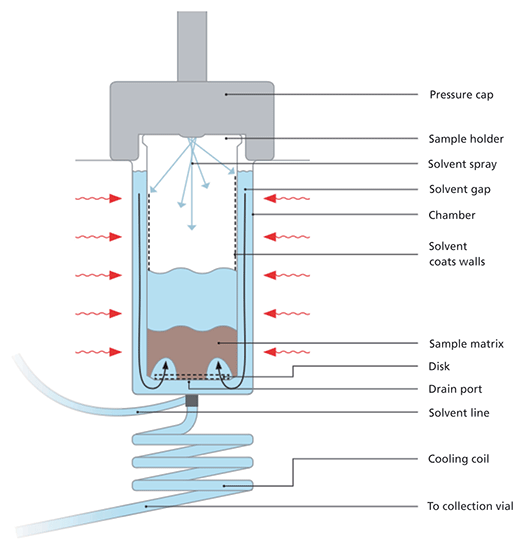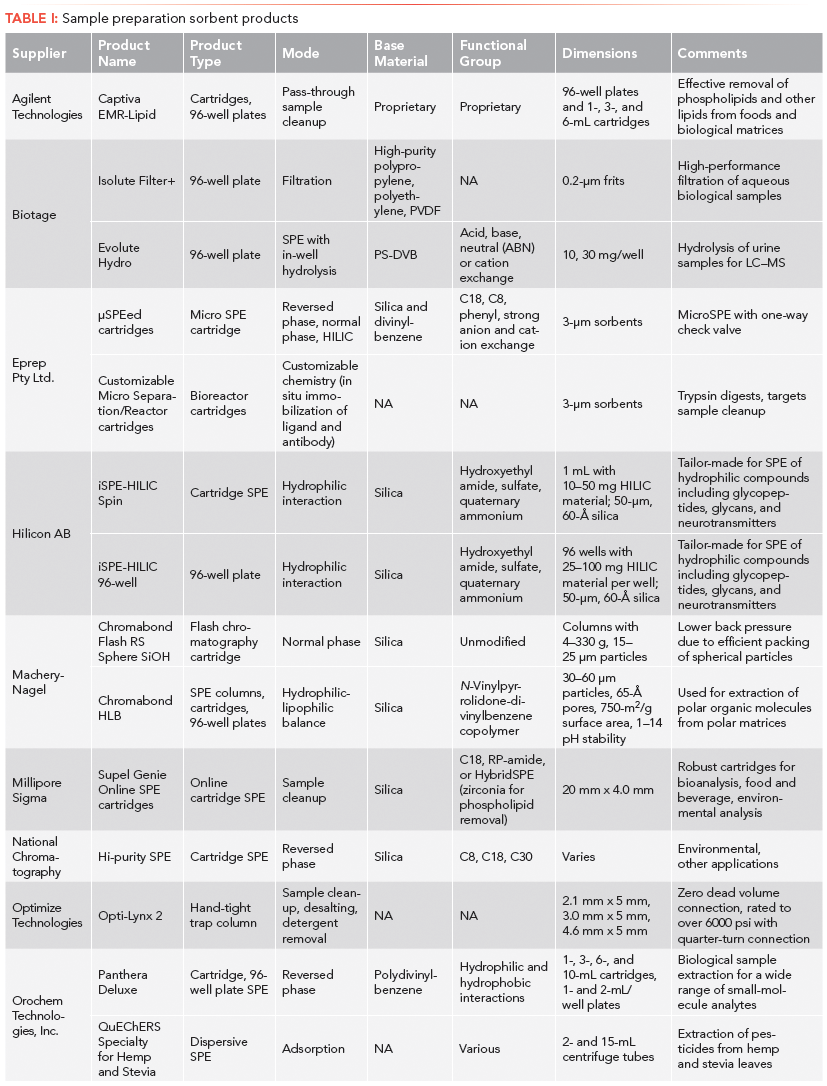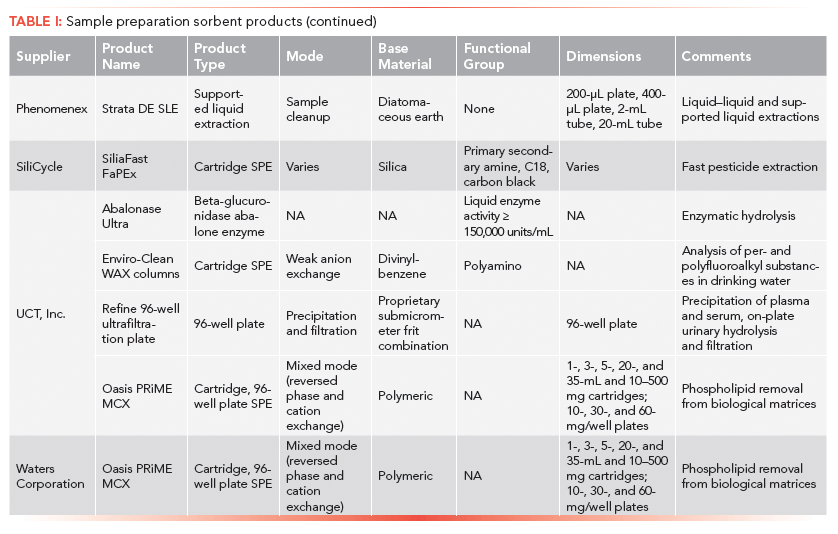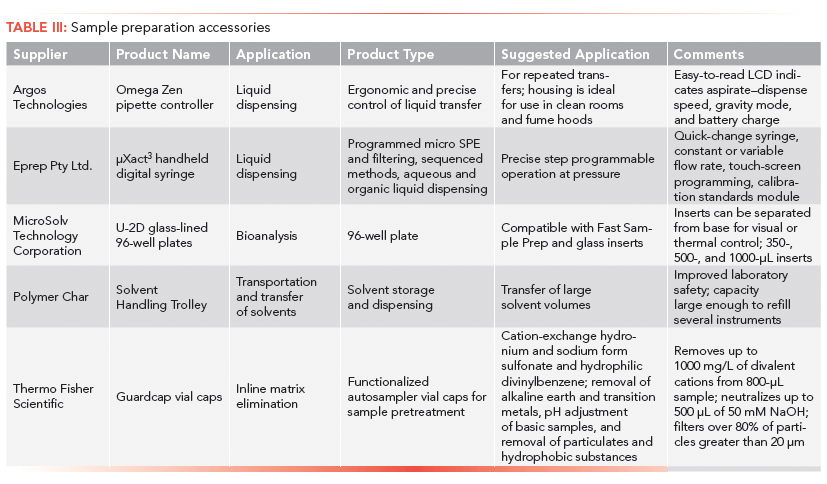New Sample Preparation Products and Accessories
LCGC North America
Our yearly report on new products covers sample preparation instrumentation, supplies, and accessories. New sample preparation technologies introduced in the past year, while not necessarily disruptive, take giant leaps in that direction.
New sample preparation technologies introduced in the past year, while not necessarily disruptive, take giant leaps in that direction. These technologies will eliminate solvent use and operating costs without sacrificing efficiency or selectivity. Thus, two new product introductions in the past year, CEM's Energized Dispersive Guided Extraction (EDGE) system and Entech's Pulsed Evaporative Concentration Extraction (PECE) system lead the way in terms of product innovations.
Our annual review of sample preparation products covers the previous year. The primary focus is new product introductions at Pittcon, although this is not the exclusive focus. In late 2017, the LCGC editorial staff submitted a survey to vendors of sample preparation products. Responses to this survey are compiled in this review. Additionally, a keyword search using the terms "sample preparation" and "extraction" was conducted for exhibitors at Pittcon 2018; then each of these vendors was visited. Even a conversation on the shuttle bus from the hotel to the convention center yielded knowledge of new product technology. Although attempts were made to be as inclusive as possible, we apologize for any oversight.
This review is presented in three sections. First, we discuss two innovative directions in extraction technology. Next, new solid-phase sorbents and sorbent-based products are presented. Sorbent technologies are seeing increased development for both general and selective purposes. Finally, we turn to other sample preparation instrumentation, accessories, and supporting technologies. To provide readers with some of the details behind these new products, each section presents a tabular summary of the associated products. In all cases, the new products we uncovered are presented in the annotated table, and the text highlights particularly worthwhile products.
New Extraction Modes
Energized Dispersive Guided Extraction
Foregoing the application of microwaves upon which the company was founded, CEM introduced the EDGE system as its entry into the world of pressurized solvent extraction (PSE). (For full disclosure, I evaluated early iterations of the equipment during CEM product development.) A schematic of the system's extraction process is shown in Figure 1. This approach is somewhat different than that used by other vendors. In this approach, extracting solvent initially is added through the bottom of the sample vessel. Then the sample is fully wetted by a solvent spray coming from the top. As the solvent-coated vessel walls are heated, a thermal gradient is created, which results in a pressure gradient. The increased pressure forces solvent down through the sample, which CEM calls the energized dispersive effect. Extraction temperatures up to 200 °C can be used, though 100 °C is generally sufficient. Data for the extraction of several semivolatile organic compounds (SVOCs) in environmental solids shows quantitative recoveries. The system is reportedly capable of running 12 samples/h. The company received a bronze Pittcon Today Excellence Award for the system, among vendors with similar reported annual sales.

Figure 1: Schematic diagram of the extraction vessel and solvent flow during energized dispersive guided extraction. (Courtesy of CEM Corp.)
Pulsed Evaporative Concentration Extraction
Previously, Entech Instruments developed vacuum-assisted sorbent extraction (VASE) and sorbent pens for headspace sampling of volatile compounds. They have expanded this approach to SVOCs and less-volatile materials, with up to six-ring aromatics, using what they term pulsed evaporative concentration extraction (PECE). PECE operates by taking advantage of solute volatilization at reduced pressure, with cycles consisting of periods of increased pressure with lower temperature, and application of temperature differentials across their extraction vessel. This process results in the evaporation of analytes followed by condensation onto the sorbent pen; by cycling through the process, analytes build up on the sorbent material. When combined with splitless injection for gas chromatography (GC), significant sensitivities are achieved.
Solid-Phase Sorbents and Products
The use of solid-phase sorbents in techniques like solid-phase extraction (SPE), solid-phase microextraction (SPME), stir-bar sorptive extraction (SBSE), and others is becoming well-established for analytical extraction and sample cleanup, though development of new, often selective, phases continues. Products and accessories specifically for these sorbent-based extractions will be discussed in the following section, but here we look specifically at new (bulk) sorbent phases. These sorbents are summarized in Tables I and II. Note that this year there did not appear to be any emerging theme in new sorbents. One modality (for example, reversed phase versus mixed mode versus ion exchange, and so on) or technique (cartridge-based SPE, dispersive SPE, SPME, and so forth) did not predominate the product offerings. Notable sorbent offerings are discussed below.

One problem associated with QuEChERS (quick, easy, cheap, effective, rugged, and safe) and other forms of dispersive SPE is the coextraction of lipids from fatty samples. This problem includes interferences associated with phospholipids after protein precipitation of biological fluids. Agilent Technologies addresses this problem with the development of the Captiva EMR-Lipid sorbent. The Captiva product appears to be a restricted access material along the lines of Agilent's Bond Elut EMR-Lipid sorbent, introduced last year, in a format amenable to cartridges and 96-well plates. Company literature shows superior results to other sorbent-based materials, such as zirconia. (For full disclosure, I am involved in an Agilent-funded project investigating the physical chemistry of dispersive SPE sorbents.)

Eprep, an Australian company, developed a series of syringe-based microseparation cartridges for SPE. Although other syringe-based forms of SPE, including Micro Extraction by Packed Sorbent (MEPS, by SGE), dispersive pipette extraction, and others are well-established, what distinguishes the Eprep μSPEed product is the use of a miniature, one-way valve, depicted in Figure 2, which allows greater control over solvent flow. Combined with the increased surface area of the 3-μm particles used, significant savings in time and solvent volume are achieved, along with very high analyte concentration factors.

Figure 2: μSPEed cartridges from Eprep, showing (a) the integrated one-way valve and (b) the sample loading and dispersion, solvent loading, and elution steps. (Courtesy of Eprep Pty Ltd.)
Sample Preparation Instrumentation, Accessories, and Related Products
Sample preparation instrumentation and other products, including those previously discussed, are summarized in Tables II and III.

Sample Preparation Instrumentation
Sample concentration via solvent evaporation is important in many sample preparation processes. Biotage expanded its popular TurboVap line with two new offerings. This equipment has smaller footprints and an improved nozzle design and sensors for extended use. After solvent evaporation, the next step typically involves solvent transfer, such as internal standard or reagent addition or aliquot generation. This array of steps can be robotically handled with Eprep's sample preparation workstation, with capability to handle up to 1000 samples.

Sample particle size reduction and sample homogenization are vital in many instances. Fritsch emphasized its expanded product line with new cutting, impacting, knife, and planetary mills. With proper selection of the suitable mill, brittle, hard, fibrous, moist, or oily samples can be accommodated with mills with smaller footprints and increased capacities.
Accessories
Every once in a while, a new product addresses a need so obvious that we were all blind to it. Polymer Char introduced a solvent handling trolley, a cart with associated connections and valving to transfer fresh and waste solvents to chromatographic systems. Not only will this system prevent the necessity of frequently lifting solvent bottles, but safety advantages associated with reduced spillage, minimal exposure to solvent vapors, and less direct solvent contact should make this worth considering in all laboratories.
Not tabulated, the Xylem model 4100 VOC analyzer and 4760 purge-and-trap concentrator from OI Analytical were upgraded with new gaskets, automated standard addition, and related features for improved performance. A new company, Biotix Fluid Innovation, developed a locking microcentrifuge tube to alleviate spillage and errors in the laboratory.
Conclusion and Future Directions
New sample preparation products in the past year seem very interesting. On one hand, significant developments in extraction, headspace and thermal desorption, sample grinding, liquid dispensing, and selective sorbents, were highly prevalent. Yet there was no clear-cut focus, no long-standing industry problem being addressed. Whether the trend in coming years is aimed at tool-building or problem-solving for food, environmental, and related analysis is the question. Nonetheless, highly significant offerings were made this year that should excite all analysts.
ABOUT THE COLUMN EDITOR
Douglas E. Raynie

Douglas E. Raynie"Sample Prep Perspectives" editor Douglas E. Raynie is a Department Head and Associate Professor at South Dakota State University. His research interests include green chemistry, alternative solvents, sample preparation, high-resolution chromatography, and bioprocessing in supercritical fluids. He earned his PhD in 1990 at Brigham Young University under the direction of Milton L. Lee. Raynie is a member of LCGC's editorial advisory board. Direct correspondence about this column via e-mail to LCGCedit@ubm.com

Thermodynamic Insights into Organic Solvent Extraction for Chemical Analysis of Medical Devices
April 16th 2025A new study, published by a researcher from Chemical Characterization Solutions in Minnesota, explored a new approach for sample preparation for the chemical characterization of medical devices.
Study Explores Thin-Film Extraction of Biogenic Amines via HPLC-MS/MS
March 27th 2025Scientists from Tabriz University and the University of Tabriz explored cellulose acetate-UiO-66-COOH as an affordable coating sorbent for thin film extraction of biogenic amines from cheese and alcohol-free beverages using HPLC-MS/MS.
Multi-Step Preparative LC–MS Workflow for Peptide Purification
March 21st 2025This article introduces a multi-step preparative purification workflow for synthetic peptides using liquid chromatography–mass spectrometry (LC–MS). The process involves optimizing separation conditions, scaling-up, fractionating, and confirming purity and recovery, using a single LC–MS system. High purity and recovery rates for synthetic peptides such as parathormone (PTH) are achieved. The method allows efficient purification and accurate confirmation of peptide synthesis and is suitable for handling complex preparative purification tasks.

.png&w=3840&q=75)

.png&w=3840&q=75)



.png&w=3840&q=75)



.png&w=3840&q=75)






